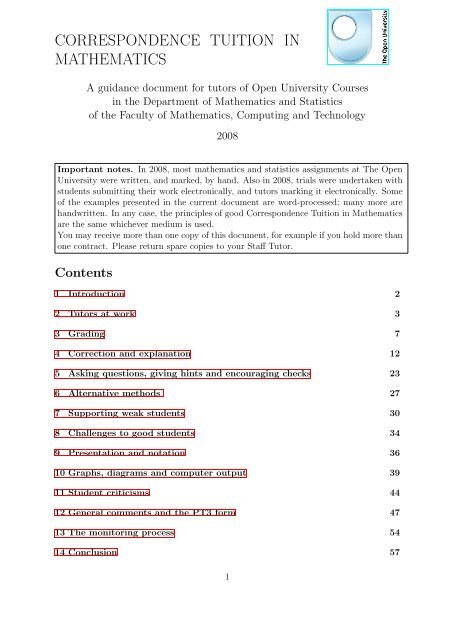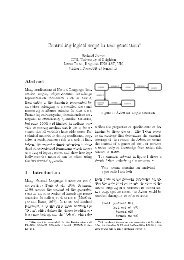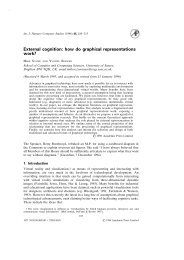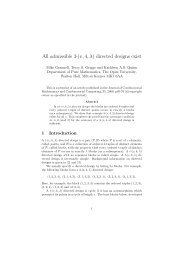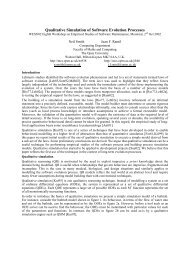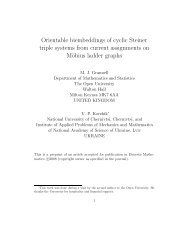correspondence tuition in mathematics - Faculty of Maths and ...
correspondence tuition in mathematics - Faculty of Maths and ...
correspondence tuition in mathematics - Faculty of Maths and ...
You also want an ePaper? Increase the reach of your titles
YUMPU automatically turns print PDFs into web optimized ePapers that Google loves.
CORRESPONDENCE TUITION IN<br />
MATHEMATICS<br />
A guidance document for tutors <strong>of</strong> Open University Courses<br />
<strong>in</strong> the Department <strong>of</strong> Mathematics <strong>and</strong> Statistics<br />
<strong>of</strong> the <strong>Faculty</strong> <strong>of</strong> Mathematics, Comput<strong>in</strong>g <strong>and</strong> Technology<br />
2008<br />
Important notes. In 2008, most <strong>mathematics</strong> <strong>and</strong> statistics assignments at The Open<br />
University were written, <strong>and</strong> marked, by h<strong>and</strong>. Also <strong>in</strong> 2008, trials were undertaken with<br />
students submitt<strong>in</strong>g their work electronically, <strong>and</strong> tutors mark<strong>in</strong>g it electronically. Some<br />
<strong>of</strong> the examples presented <strong>in</strong> the current document are word-processed; many more are<br />
h<strong>and</strong>written. In any case, the pr<strong>in</strong>ciples <strong>of</strong> good Correspondence Tuition <strong>in</strong> Mathematics<br />
are the same whichever medium is used.<br />
You may receive more than one copy <strong>of</strong> this document, for example if you hold more than<br />
one contract. Please return spare copies to your Staff Tutor.<br />
Contents<br />
1 Introduction 2<br />
2 Tutors at work 3<br />
3 Grad<strong>in</strong>g 7<br />
4 Correction <strong>and</strong> explanation 12<br />
5 Ask<strong>in</strong>g questions, giv<strong>in</strong>g h<strong>in</strong>ts <strong>and</strong> encourag<strong>in</strong>g checks 23<br />
6 Alternative methods 27<br />
7 Support<strong>in</strong>g weak students 30<br />
8 Challenges to good students 34<br />
9 Presentation <strong>and</strong> notation 36<br />
10 Graphs, diagrams <strong>and</strong> computer output 39<br />
11 Student criticisms 44<br />
12 General comments <strong>and</strong> the PT3 form 47<br />
13 The monitor<strong>in</strong>g process 54<br />
14 Conclusion 57<br />
1
1 Introduction<br />
As an Associate Lecturer (AL) <strong>of</strong> the Open University, you have access to the Support<strong>in</strong>g<br />
Open Learners (SOL) website, http://www.open.ac.uk/tutors/sol/. The site<br />
provides a good reference guide to general aspects <strong>of</strong> <strong>correspondence</strong> <strong>tuition</strong>, resources to<br />
aid ALs <strong>in</strong> support<strong>in</strong>g their students, <strong>and</strong> also the adm<strong>in</strong>istrative <strong>in</strong>formation you need<br />
to deal with Tutor-Marked Assignments (TMAs). We suggest that you take a look at the<br />
website before you cont<strong>in</strong>ue with this document.<br />
It takes time to assimilate the more general material on the SOL site, <strong>and</strong> to relate<br />
comments to the task <strong>in</strong> h<strong>and</strong> – particularly if you’re new to the University. Correspondence<br />
<strong>tuition</strong> <strong>in</strong> <strong>mathematics</strong> is, <strong>in</strong> some ways, rather different from <strong>correspondence</strong><br />
<strong>tuition</strong> <strong>in</strong> subjects that <strong>in</strong>volve students primarily <strong>in</strong> essay writ<strong>in</strong>g.<br />
We therefore th<strong>in</strong>k it’s helpful to provide you with a subject-specific booklet: you may<br />
appreciate the chance to see illustrations <strong>of</strong> general pr<strong>in</strong>ciples at work <strong>in</strong> <strong>mathematics</strong>,<br />
through examples <strong>of</strong> students scripts <strong>and</strong> the comments that tutors have made on them.<br />
New courses <strong>and</strong> chang<strong>in</strong>g methods <strong>of</strong> delivery, especially electronic mark<strong>in</strong>g, will give<br />
opportunities for a different process for provid<strong>in</strong>g <strong>correspondence</strong> <strong>tuition</strong> compared to paper<br />
mark<strong>in</strong>g. Nevertheless, the common core <strong>of</strong> good practice rema<strong>in</strong>s the same whatever<br />
the medium – so the ideas illustrated here rema<strong>in</strong> relevant.<br />
Tutors naturally have <strong>in</strong>dividual styles <strong>of</strong> comment<strong>in</strong>g, <strong>and</strong> what sounds right when<br />
written by one can sound artificial from another. This makes it tricky to lay down a<br />
set <strong>of</strong> hard-<strong>and</strong>-fast rules for good <strong>correspondence</strong> <strong>tuition</strong>, but there are guidel<strong>in</strong>es to<br />
follow. These are set out <strong>in</strong> detail <strong>in</strong> Sections 3 to 12, where we also provide coverage <strong>of</strong><br />
some frequently encountered situations, along with examples <strong>of</strong> a variety <strong>of</strong> tutors ways<br />
<strong>of</strong> deal<strong>in</strong>g with them.<br />
The po<strong>in</strong>ts we make are illustrated by <strong>in</strong>stances <strong>of</strong> what we consider both good <strong>and</strong><br />
bad tutor<strong>in</strong>g practice; for simplicity, most <strong>of</strong> the examples are taken from first <strong>and</strong> second<br />
level courses. Although there may not be any from the course which you’re teach<strong>in</strong>g, we<br />
hope that many <strong>of</strong> the examples will be relevant to your work. We believe they cover most<br />
<strong>of</strong> the different types <strong>of</strong> situation that are likely to arise <strong>in</strong> <strong>mathematics</strong> <strong>and</strong> statistics<br />
courses.<br />
We beg<strong>in</strong> the booklet with some thoughts upon start<strong>in</strong>g to mark a batch <strong>of</strong> scripts for<br />
courses which we tutor ourselves. This is followed by the ma<strong>in</strong> sections, <strong>in</strong>clud<strong>in</strong>g a range<br />
<strong>of</strong> examples; then we look at the monitor<strong>in</strong>g process <strong>and</strong> how it will affect you. The back<br />
cover provides an at-a-glance summary sheet <strong>of</strong> good practice po<strong>in</strong>ts that can be used<br />
alongside the Tutor Notes for your course.<br />
We hope that this booklet will help you to:<br />
• establish processes to manage your mark<strong>in</strong>g <strong>of</strong> TMAs;<br />
• grade student work <strong>in</strong> accordance with the guidel<strong>in</strong>es for your course;<br />
• encourage student progress through appropriate feedback;<br />
2
• appreciate monitor<strong>in</strong>g as a quality assurance mechanism <strong>and</strong> as part <strong>of</strong> staff development;<br />
<strong>and</strong><br />
• know how to obta<strong>in</strong> further help if needed.<br />
We, the authors, would like to thank those who wrote the orig<strong>in</strong>al document upon<br />
which the current version is based, <strong>and</strong> the many others who have helped <strong>in</strong> the revision;<br />
academic, secretarial, full-time <strong>and</strong> part-time staff, <strong>in</strong>clud<strong>in</strong>g Associate Lecturers who<br />
have, know<strong>in</strong>gly or unknow<strong>in</strong>gly, provided examples for our use.<br />
Gaynor Arrowsmith Mike Innes Gwil Stephenson<br />
Cath Gornall Alison Neil Cath Wilk<strong>in</strong>s<br />
Ian Harrison Sylvia Neumann Frances Williams<br />
Mike Herr<strong>in</strong>g Philip Shelton Gareth Williams<br />
2 Tutors at work<br />
MST121 Us<strong>in</strong>g Mathematics – Cath<br />
I have my first batch <strong>of</strong> MST121, Us<strong>in</strong>g Mathematics, preparatory TMAs to mark. This<br />
is a formative assignment <strong>and</strong> students are encouraged to submit it as early as possible,<br />
so scripts tend to arrive over a couple <strong>of</strong> weeks. It is important for students to receive<br />
early feedback, so I mark the TMAs <strong>and</strong> send them to Walton Hall as soon as I can.<br />
The preparatory TMA is an opportunity for me to judge whether students are ready<br />
to study MST121. Many <strong>of</strong> the assignments will be very good <strong>and</strong> will need only brief<br />
comments. However, I am go<strong>in</strong>g to have to be very careful with the ones that are not so<br />
good; most <strong>of</strong> the students are new to the Open University <strong>and</strong> I dont want to put them<br />
<strong>of</strong>f at this early stage. At the same time, I need to be realistic about their work <strong>and</strong> it<br />
may be that they should be th<strong>in</strong>k<strong>in</strong>g about chang<strong>in</strong>g course (probably to MU120, Open<br />
Mathematics), but I have to be very sensitive about this. I will follow up any weak scripts<br />
with a phone call a few days after they have received their scripts back.<br />
Question 1 is on numbers <strong>in</strong>clud<strong>in</strong>g surds, powers, <strong>and</strong> logarithms. It is answered very<br />
well, although some students have not shown all their work<strong>in</strong>g <strong>and</strong> I comment on the<br />
importance <strong>of</strong> this.<br />
Questions 2, 3 <strong>and</strong> 4 are on algebra <strong>in</strong>clud<strong>in</strong>g solv<strong>in</strong>g equations <strong>and</strong> <strong>in</strong>equalities. Some<br />
students reveal that their techniques are a little rusty. I stress the need for fluent algebra<br />
skills <strong>and</strong> suggest that some extra practice might be useful, provid<strong>in</strong>g references to helpful<br />
sections <strong>of</strong> the Revision Pack. In particular, a number <strong>of</strong> students seem overly reliant on<br />
the quadratic formula <strong>and</strong> I show them how they could have obta<strong>in</strong>ed some results more<br />
easily us<strong>in</strong>g factorisation.<br />
Question 5 is on l<strong>in</strong>ear graphs, po<strong>in</strong>ts <strong>of</strong> <strong>in</strong>tersection <strong>and</strong> simultaneous equations. Most<br />
students have provided very good answers, although there is some reluctance to add any<br />
words expla<strong>in</strong><strong>in</strong>g what they’re do<strong>in</strong>g.<br />
Questions 6 <strong>and</strong> 7 are on geometry <strong>and</strong> trigonometry <strong>in</strong>clud<strong>in</strong>g the use <strong>of</strong> radians. Most<br />
students clearly know what they are do<strong>in</strong>g, but many <strong>of</strong> them have <strong>in</strong>troduced round<strong>in</strong>g<br />
3
errors <strong>and</strong> I expla<strong>in</strong> how this can be avoided. There are also some presentational issues<br />
to comment on, such as <strong>in</strong>appropriate use <strong>of</strong> the equals symbol. Once aga<strong>in</strong> I comment<br />
on the need for clear explanations. This is clearly a common problem!<br />
Question 8 is an ungraded question <strong>in</strong>vit<strong>in</strong>g students to share with the tutor some<br />
details <strong>of</strong> their mathematical background, feel<strong>in</strong>gs about their preparatory work <strong>and</strong> plans<br />
to improve their study methods. Some students will choose not to do this. For those who<br />
have, I comment briefly on the po<strong>in</strong>ts raised <strong>and</strong> thank them for the <strong>in</strong>formation. I also<br />
make a note to contact any student who has raised an issue I th<strong>in</strong>k may need further<br />
discussion.<br />
A couple <strong>of</strong> days after the course <strong>of</strong>ficially starts I will contact any students who have<br />
not submitted the preparatory TMA. There may be one or two who are not <strong>in</strong>tend<strong>in</strong>g<br />
to cont<strong>in</strong>ue with the course <strong>and</strong> I will rem<strong>in</strong>d them to contact the Regional Centre to<br />
withdraw as soon as possible. There may also be some who are reluctant to tackle the<br />
TMA or who have registered late <strong>and</strong> I will encourage them to try perhaps just two or<br />
three <strong>of</strong> the questions, whilst rem<strong>in</strong>d<strong>in</strong>g them <strong>of</strong> the importance <strong>of</strong> future cut-<strong>of</strong>f dates.<br />
MS221 Explor<strong>in</strong>g Mathematics – Alison<br />
It is the day after the cut-<strong>of</strong>f date for TMA02 <strong>and</strong> I have a pile <strong>of</strong> scripts to mark. I<br />
have begun to know my students by now <strong>and</strong> am glad to have the opportunity to read<br />
their work <strong>and</strong> see how they are gett<strong>in</strong>g on. I like to mark one script at a time, so I<br />
can engage with each student <strong>and</strong> get a good overall impression <strong>of</strong> their strengths <strong>and</strong><br />
weaknesses. Occasionally I’ll take one question <strong>and</strong> mark it for a batch <strong>of</strong> scripts, if I<br />
anticipate difficulties with the mark<strong>in</strong>g, but that’s not so this time. I like to start <strong>of</strong>f<br />
with a very good assignment if possible, just to get <strong>in</strong>to the sw<strong>in</strong>g <strong>of</strong> the mark scheme,<br />
before tackl<strong>in</strong>g weaker ones where there will be more problems. I have my black <strong>and</strong> blue<br />
pens ready, as I always use black for students who write <strong>in</strong> blue, <strong>and</strong> vice versa, hav<strong>in</strong>g a<br />
personal aversion to red <strong>in</strong>k.<br />
The first question is about fixed po<strong>in</strong>ts. Inevitably some students will still be us<strong>in</strong>g<br />
the quadratic formula rather than factoris<strong>in</strong>g neatly, so that will be worth a comment.<br />
Some students leave out the modulus signs when test<strong>in</strong>g the nature <strong>of</strong> the fixed po<strong>in</strong>ts, so<br />
that needs an important note, <strong>and</strong> the loss <strong>of</strong> a mark for reason<strong>in</strong>g. If they get the fixed<br />
po<strong>in</strong>ts wrong, I will have to follow-through the marks for the rest <strong>of</strong> the question.<br />
I add up the marks, <strong>and</strong> as a check add the lost marks too, round<strong>in</strong>g up any odd<br />
half-mark at the end. I tend not to penalise for <strong>in</strong>correct notation, though I always po<strong>in</strong>t<br />
it out – misuse <strong>of</strong> = signs is a frequent one! – but I take <strong>of</strong>f half a mark when I’m really<br />
unhappy about it. Occasionally too, where the mark scheme doesn’t dictate otherwise,<br />
I’ll take <strong>of</strong>f half a mark for <strong>in</strong>correct round<strong>in</strong>g or for small omissions. I have a pocketful<br />
<strong>of</strong> words such as “good” or “all f<strong>in</strong>e” or “beautifully clear”, with which I scatter nicely<br />
done sections.<br />
Question 2 requires the use <strong>of</strong> Mathcad; a few students leave it out completely, claim<strong>in</strong>g<br />
computer problems, or lack <strong>of</strong> time. Most tackle it quite well, but some lose marks through<br />
their reluctance to write detailed conclusions, leav<strong>in</strong>g it for me to pick out their answers<br />
4
<strong>in</strong> their pr<strong>in</strong>t-outs, which, to compound matters, are sometimes appended at the back <strong>of</strong><br />
their scripts! Others fail to <strong>in</strong>crease the number <strong>of</strong> iterations sufficiently to get a clear<br />
picture <strong>of</strong> any convergence: the sequence converges to an 8-cycle after about a hundred<br />
iterations, but many just look at ten iterations <strong>and</strong> conclude the sequence is chaotic. So<br />
there is plenty <strong>of</strong> scope for comment.<br />
The next question is short, about b<strong>in</strong>omial coefficients, <strong>and</strong> many students get full<br />
marks, so it’s a quick <strong>and</strong> easy one for me. But for some there’s confusion between “term”<br />
<strong>and</strong> “coefficient”, <strong>and</strong> there are a few sign errors, <strong>and</strong> some decimal approximations to<br />
what should be exact answers.<br />
Question 4 is about transformations <strong>and</strong> matrices. I sense that a few students are<br />
writ<strong>in</strong>g down solutions by rote, with little underst<strong>and</strong><strong>in</strong>g <strong>of</strong> what they are do<strong>in</strong>g, so if<br />
there is not enough justification they will lose a mark, <strong>and</strong> I’ll fill <strong>in</strong> the reason<strong>in</strong>g for<br />
them as clearly as I can. At the end there is another Mathcad exercise, about writ<strong>in</strong>g<br />
a matrix as a product <strong>of</strong> simple scal<strong>in</strong>g / shear / rotation matrices, with neat diagrams<br />
show<strong>in</strong>g a unit square be<strong>in</strong>g transformed <strong>in</strong>to a parallelogram, but I get several scripts<br />
which tell me that the matrix is just the identity I, so clearly they had no idea <strong>of</strong> what<br />
they were supposed to do, <strong>and</strong> I refer them to the box <strong>and</strong> activity <strong>in</strong> the computer<br />
booklet which expla<strong>in</strong>s the process; they still get 2 <strong>of</strong> the 5 marks though, for enter<strong>in</strong>g<br />
the orig<strong>in</strong>al matrix correctly.<br />
Next, Question 5 is about aff<strong>in</strong>e transformations <strong>and</strong> composites, with more matrices.<br />
Most <strong>of</strong> the students run <strong>in</strong>to trouble here, <strong>of</strong>ten with f<strong>in</strong>d<strong>in</strong>g the composite (there’s<br />
no similar example <strong>in</strong> the chapter or <strong>in</strong> the exercise book); so I congratulate those who<br />
worked it out correctly for themselves, <strong>and</strong> write solutions for those who got stuck. I also<br />
have to do quite a lot <strong>of</strong> follow-through mark<strong>in</strong>g!<br />
There are issues <strong>of</strong> notation here too; use <strong>of</strong> brackets, underl<strong>in</strong><strong>in</strong>g vectors, dist<strong>in</strong>guish<strong>in</strong>g<br />
between a vector <strong>and</strong> a po<strong>in</strong>t.<br />
Lastly Question 6 is about eigenvalues, eigenl<strong>in</strong>es, <strong>and</strong> eigenvectors. Nearly everyone<br />
gets the first two or three sections right; for those who don’t I po<strong>in</strong>t out how they could<br />
have checked their answers (if the square matrix A has <strong>in</strong>teger entries, so should the<br />
matrix A 6 !). But there are more problems <strong>in</strong> the later sections, about the behaviour<br />
<strong>of</strong> iteration sequences <strong>of</strong> po<strong>in</strong>ts start<strong>in</strong>g on or <strong>of</strong>f an eigenl<strong>in</strong>e, with one section another<br />
Mathcad exercise. Often their description <strong>of</strong> the behaviour lacks detail <strong>and</strong> justification,<br />
<strong>and</strong> I’m not always sure they see the l<strong>in</strong>ks between the various parts <strong>of</strong> the question,<br />
so I write out the solution for them <strong>and</strong> refer them to to the detailed description <strong>in</strong> the<br />
h<strong>and</strong>book, <strong>and</strong> to similar activities <strong>in</strong> the chapter. It might have been worth writ<strong>in</strong>g out<br />
my own solution once <strong>and</strong> for all, <strong>and</strong> photocopy<strong>in</strong>g it , but I do like to tie up the solution<br />
<strong>and</strong> notes I write on their script with their work as much as possible.<br />
F<strong>in</strong>ally I write up the PT3 form. I always address it to the student, (hop<strong>in</strong>g at the<br />
start <strong>of</strong> the course to have their first name right!), <strong>and</strong> I aim to write <strong>in</strong> a friendly,<br />
positive style. There is always someth<strong>in</strong>g I can praise to start with, a question which got<br />
full marks, good presentation, neat diagrams, etc. I know full well that for some students<br />
a mark <strong>of</strong> 60%, say, is quite an achievement <strong>and</strong> that with support <strong>and</strong> encouragement<br />
they may be able to improve on this. I draw their attention to two or three po<strong>in</strong>ts to note<br />
5
especially, e.g use <strong>of</strong> modulus signs, or how to form composites; I hope this encourages<br />
them to look at my comments <strong>in</strong>side <strong>and</strong> may be useful later when they are revis<strong>in</strong>g for<br />
the exam. I f<strong>in</strong>ish by look<strong>in</strong>g ahead to the next block, <strong>and</strong> encourag<strong>in</strong>g them to contact<br />
me if they have queries or run <strong>in</strong>to difficulties. If any student seems to be struggl<strong>in</strong>g I’ll<br />
make a note to contact them.<br />
Then it’s onto the next student’s script; it’s good to see the pile go<strong>in</strong>g down <strong>and</strong> even<br />
better to get them all <strong>in</strong> the post!<br />
M208 Pure Mathematics – Ian<br />
It is the day after the cut-<strong>of</strong>f date for TMA03 <strong>of</strong> M208, Pure Mathematics. I had about<br />
six scripts a week ago; this is somewhat unusual by this stage <strong>of</strong> the course, but a few<br />
students told me they needed to get ahead because <strong>of</strong> holidays or go<strong>in</strong>g abroad. As the<br />
assignments came <strong>in</strong> I noted their arrival date on the PT3 <strong>and</strong> collected them together<br />
<strong>in</strong> one large envelope. When about six had come <strong>in</strong>, as I had a day available, I started<br />
mark<strong>in</strong>g them. I always mark script by script, but like to have a reasonable number before<br />
I get go<strong>in</strong>g so that I can compare them <strong>and</strong> check that I am be<strong>in</strong>g consistent, especially<br />
over errors that appear repeatedly.<br />
I’ve made a few comments on my Tutor Notes by now – some extra references which<br />
may be useful, a note <strong>of</strong> any errors, <strong>of</strong> common alternative solutions <strong>and</strong> <strong>of</strong> any po<strong>in</strong>ts<br />
where the mark scheme seems a bit odd <strong>and</strong> I may need to use my discretion over a mark<br />
or two. Just after the cut-<strong>of</strong>f date I’ve sent <strong>of</strong>f the first batch; I don’t send them too early<br />
<strong>in</strong> case the students should then get them back before the cut-<strong>of</strong>f date <strong>and</strong> show their<br />
fellow students any <strong>of</strong> my model solutions!<br />
I have given four students permission to send this TMA <strong>in</strong> late, but most <strong>of</strong> the rest<br />
have now come <strong>in</strong>, so I get out my green pen to get on with the next batch. This TMA<br />
is one which most people can do fairly well, but many <strong>of</strong> them get the notation slightly<br />
wrong, so that is someth<strong>in</strong>g I have to pay particular attention to. There’s also a lot <strong>of</strong><br />
arithmetic <strong>in</strong>volved, <strong>and</strong> <strong>of</strong> course this means there are numerical mistakes which may<br />
make subsequent answers wrong.<br />
I have to check the follow-through carefully, but sometimes the errors mean that the<br />
later work is easier than the correct solution, <strong>in</strong> which case I don’t give all the followthrough<br />
marks. I po<strong>in</strong>t out checks that could be done to avoid or correct these errors.<br />
Question 5 is rather tricky <strong>and</strong> I f<strong>in</strong>d myself writ<strong>in</strong>g out all or part <strong>of</strong> a solution quite<br />
<strong>of</strong>ten. In retrospect perhaps I should have written it out once <strong>and</strong> made some photocopies<br />
to attach to some scripts. As I mark each question, where I deduct marks I write the<br />
negative marks on the sp<strong>in</strong>e <strong>of</strong> the PT3 form.<br />
If a student is do<strong>in</strong>g well – not los<strong>in</strong>g marks – I may not itemise every subtotal from<br />
the mark scheme, but carry marks through until I come to an error. Then I shall write<br />
an appropriate itemised mark at the end <strong>of</strong> the section before the mistake, so that I can<br />
show more detail with the marks where there is an error.<br />
At the end <strong>of</strong> mark<strong>in</strong>g a question, I add up the marks on the script <strong>and</strong> check with<br />
the negative marks, before writ<strong>in</strong>g the total for the question <strong>in</strong> the appropriate box. On<br />
6
the PT3, I draw a l<strong>in</strong>e under the negative marks so far, <strong>in</strong> order to separate them from<br />
those for the next question.<br />
At the end <strong>of</strong> mark<strong>in</strong>g an assignment, I have the double check <strong>of</strong> the totals <strong>in</strong> the boxes<br />
<strong>of</strong> the PT3 aga<strong>in</strong>st the total negative marks on the sp<strong>in</strong>e. A significant proportion <strong>of</strong> PT3<br />
forms from <strong>mathematics</strong> tutors are rejected because the overall grade is not correct; I use<br />
the negative marks to try not to contribute to this problem!<br />
Before I write comments on the PT3 form I look at the student’s PT3 for TMA02,<br />
compare the grade achieved on the two assignments <strong>and</strong> look at the comments I wrote<br />
last time. Obviously I don’t want to use exactly the same words as before, but I also want<br />
to see whether the student has taken note <strong>of</strong> any suggestions I may have made previously.<br />
Some students have, <strong>and</strong> I commend them for this. At least one, however, is still los<strong>in</strong>g<br />
marks by writ<strong>in</strong>g far too little explanation; I tell him about it aga<strong>in</strong> <strong>and</strong> I hope he takes<br />
more notice this time!<br />
Another student – who cannot attend tutorials or day schools because she works on<br />
Saturdays – is hav<strong>in</strong>g a lot <strong>of</strong> difficulty. I’ve tried to persuade her to r<strong>in</strong>g me up for help,<br />
but she seems very reluctant to do so. So I will now take the <strong>in</strong>itiative <strong>and</strong> r<strong>in</strong>g her to<br />
suggest a “special session”. Most students are do<strong>in</strong>g well, however, <strong>and</strong> I’m pleased that<br />
this year I’ve only had one who’s withdrawn – though I suspect there may be another<br />
withdrawal about to happen. Next week I will telephone, or email, the three students<br />
who have neither sent <strong>in</strong> the TMA nor asked for an extension, <strong>in</strong> the hope <strong>of</strong> encourag<strong>in</strong>g<br />
them to cont<strong>in</strong>ue with the course even if they are hav<strong>in</strong>g problems.<br />
3 Grad<strong>in</strong>g<br />
Mark<strong>in</strong>g correct work is usually easy – it is when the student goes wrong that difficulties<br />
arise. Tutor notes try to <strong>in</strong>dicate the proportion <strong>of</strong> marks to give to different sections,<br />
<strong>and</strong> detail what the marks are for. Nevertheless you will f<strong>in</strong>d many occasions when you<br />
have to use your discretion if the tutor notes do not cover the type <strong>of</strong> answers given, <strong>and</strong><br />
the tutor notes may occasionally be <strong>in</strong>correct 1 . It is more important that you can justify<br />
the marks you have given than that you bl<strong>in</strong>dly obey the tutor notes.<br />
Grad<strong>in</strong>g is, <strong>in</strong> practice an <strong>in</strong>exact science. A difference <strong>of</strong> a few marks between tutors<br />
is the norm <strong>and</strong> it is only when a tutor differs from the average by a considerable amount,<br />
over the script as a whole, that alarm bells start to r<strong>in</strong>g.<br />
When mark<strong>in</strong>g there are certa<strong>in</strong> po<strong>in</strong>ts to bear <strong>in</strong> m<strong>in</strong>d:<br />
• It is important for the student to know why marks have been lost. In some cases it<br />
will be sufficient simply to correct an arithmetic error, but <strong>in</strong> all other cases, any<br />
loss <strong>of</strong> marks must be supported by an explanation to the student.<br />
• Some <strong>in</strong>dication <strong>of</strong> where the loss has occurred must also be <strong>in</strong>dicated on the script.<br />
There are many ways <strong>of</strong> do<strong>in</strong>g this depend<strong>in</strong>g on how the question is structured.<br />
It is usual to enter part marks next to each section <strong>of</strong> a question <strong>in</strong> l<strong>in</strong>e with how<br />
1 Errata are usually posted on the tutors’ First Class forum for the course.<br />
7
the marks are del<strong>in</strong>eated <strong>in</strong> the question e.g. 3/5 for a part with 5 marks available<br />
<strong>and</strong> 3 awarded. This is particularly important if the student is hav<strong>in</strong>g difficulty<br />
with many aspects <strong>of</strong> the question. Occasionally, if the student is gett<strong>in</strong>g almost<br />
everyth<strong>in</strong>g correct, a simple “−1” (with explanatory comments), <strong>and</strong> a total mark<br />
for the question at the end, may be appropriate. The practice <strong>of</strong> always us<strong>in</strong>g part<br />
marks is probably the best, <strong>and</strong> is encouraged, as it does provide a check that all<br />
parts <strong>of</strong> the solution have been marked.<br />
• You may use abbreviations when mark<strong>in</strong>g scripts as long as the first time you use<br />
them you expla<strong>in</strong> to the student the code you are us<strong>in</strong>g. The commonest ones are<br />
“b.d.” (benefit <strong>of</strong> the doubt) when you feel the student has provided a correct answer<br />
but mis<strong>in</strong>terpreted or misread a fairly trivial aspect, <strong>and</strong> “f.t.” (follow through) when<br />
you have had to follow through an <strong>in</strong>correct solution to see what effects the <strong>in</strong>itial<br />
error may have had on other parts <strong>of</strong> a question, <strong>in</strong> order to avoid over-penalis<strong>in</strong>g a<br />
student for a s<strong>in</strong>gle error.<br />
• Non-st<strong>and</strong>ard but correct work, unless contrary to the word<strong>in</strong>g <strong>of</strong> the question or<br />
the spirit <strong>of</strong> the course, usually gets full marks.<br />
• In many cases, if no work<strong>in</strong>g is shown full marks cannot be awarded. The Tutor<br />
Notes should make the practice clear. It is <strong>of</strong>ten worth rem<strong>in</strong>d<strong>in</strong>g students to look<br />
at the part <strong>of</strong> the course which expla<strong>in</strong>s what level <strong>of</strong> detail is needed when words<br />
such as “write down,” “calculate” or “prove” are used <strong>in</strong> a question. (Often, they<br />
are expla<strong>in</strong>ed on the front cover <strong>of</strong> an assignment booklet.)<br />
• If a wrong answer is obta<strong>in</strong>ed with no work<strong>in</strong>g given, then, <strong>of</strong> course, neither method<br />
nor answer marks should be given.<br />
• Marks can always be split as you feel appropriate; e.g. if part <strong>of</strong> a question has 3<br />
answer marks you can mark between 0 <strong>and</strong> 3 depend<strong>in</strong>g on how good you th<strong>in</strong>k the<br />
answer is. Often the Tutor Notes will give a mark scheme with a detailed breakdown.<br />
On some courses you can even give half a mark if you wish, so long as you round<br />
up half marks to give an <strong>in</strong>teger mark for the whole question.<br />
• You can add marks for a particularly well executed piece <strong>of</strong> work to mitigate the<br />
loss <strong>of</strong> marks elsewhere with<strong>in</strong> the same question, but this is the exception rather<br />
than the rule. Where this does occur it should only <strong>in</strong>volve a slight adjustment <strong>of</strong> 1<br />
or 2 marks. In all cases, the total number <strong>of</strong> marks for each part <strong>of</strong> a question (as<br />
def<strong>in</strong>ed by the Assignment Booklet) must be respected.<br />
• It is important to notice the process a student has gone through to achieve an<br />
answer, as well as the f<strong>in</strong>al result. A correct numerical result obta<strong>in</strong>ed via false<br />
steps should not get full marks.<br />
• If you notice that two scripts are virtually identical, <strong>and</strong> you suspect that the two<br />
students concerned have collaborated more than is appropriate, or that one student<br />
8
has copied from the other, please consult your Staff Tutor before send<strong>in</strong>g the scripts<br />
to Walton Hall.<br />
F<strong>in</strong>ally, it is worth double-check<strong>in</strong>g that you have added up all the part marks correctly<br />
<strong>and</strong> that the overall assignment mark on the PT3 is correct. There is a fairly<br />
high percentage <strong>of</strong> assignments submitted where the overall grade is <strong>in</strong>correct, even on<br />
<strong>mathematics</strong> courses. Naturally, <strong>in</strong> our case it is only due to tiredness!<br />
In the example that follows the tutor has provided part marks. Note that, as shown<br />
<strong>in</strong> this example, a total mark for a question should appear next to the solution as well as<br />
on the PT3.<br />
Example 3.1 . MS221 02<br />
It is important to let the students know where marks have been lost. The next example<br />
demonstrates how a fairly brief message from the tutor can be very helpful. Note the use<br />
<strong>of</strong> “m<strong>in</strong>us one” <strong>in</strong> brackets mak<strong>in</strong>g it explicitly clear where the mark was lost, but more<br />
importantly the part mark has been given as well.<br />
Example 3.2 . M208 03<br />
9
In the follow<strong>in</strong>g example, the solution <strong>in</strong> the Tutor Notes starts by stat<strong>in</strong>g un+1 =<br />
8 n+1 +(−6) n+1 <strong>and</strong> un−1 = 8 n−1 +(−6) n−1 separately, before substitut<strong>in</strong>g <strong>in</strong>to un+1un−1 −<br />
u 2 n. The tutor has docked a mark because the student hasn’t done this. But the question<br />
didn’t specify that this was explicitly needed, <strong>and</strong> the solution is perfectly clear, so <strong>in</strong> fact<br />
full marks would have been appropriate here.<br />
It is <strong>of</strong>ten obvious that a question was unclear if most students make the same mistake.<br />
Unfortunately, it is usually not obvious until after you have marked quite a few scripts.<br />
For this reason, it is wise to reta<strong>in</strong> early scripts until you are happy that your own mark<strong>in</strong>g<br />
scheme is correct <strong>and</strong> consistent.<br />
Example 3.3 . MS221 01<br />
In the follow<strong>in</strong>g example the tutor has <strong>in</strong>cluded no part marks on the script <strong>and</strong> has<br />
simply put a score <strong>of</strong> 3/9 on the PT3. The student will have difficulty <strong>in</strong> know<strong>in</strong>g where<br />
<strong>and</strong> why 6 marks were lost. When so many marks have been lost on a question the tutor<br />
should provide sufficient notes to allow the student to see where they have gone wrong,<br />
10
<strong>and</strong> what they need to do to improve. The two brief notes below are unlikely to assist<br />
the student to fully assess their mistakes on M249, Practical Modern Statistics.<br />
Example 3.4 . M249 02<br />
Compare with the follow<strong>in</strong>g, where the tutor expla<strong>in</strong>s fully why a mark has been lost.<br />
Example 3.5 . M249 02<br />
11
4 Correction <strong>and</strong> explanation<br />
Even more important than accurate grad<strong>in</strong>g is the teach<strong>in</strong>g which you do on an assignment.<br />
There are many ways <strong>of</strong> teach<strong>in</strong>g, <strong>and</strong> we show examples <strong>of</strong> a variety <strong>of</strong> techniques.<br />
In most cases, you can put appropriate comments <strong>and</strong> corrections on the student’s script.<br />
If there is not room on the script, you may wish to attach a separate sheet with further<br />
comments, or a model solution, referenc<strong>in</strong>g the po<strong>in</strong>t to which it applies.<br />
Copies <strong>of</strong> Tutor Notes should not be sent to students. Occasionally a course team may<br />
provide model solutions or additional notes which may be sent to students. These should<br />
be used spar<strong>in</strong>gly, <strong>and</strong> ideally should be annotated to help the student address his or her<br />
particular problems with the question. In the follow<strong>in</strong>g example, the tutor has enclosed<br />
part <strong>of</strong> a model solution <strong>and</strong> shown the student how <strong>and</strong> why the correct approach works<br />
– but has left the student to complete the question on their own.<br />
Example 4.1 . MST209 01<br />
Specimen solutions can be very useful, but they should be regarded as an addition<br />
to, rather than a substitute for, direct comments on the student’s own work. Students<br />
12
may sometimes omit all or part <strong>of</strong> a question; the above po<strong>in</strong>ts apply <strong>and</strong> you may need<br />
to make a judgement as to how much explanation <strong>and</strong> how much <strong>of</strong> a model answer you<br />
give.<br />
After read<strong>in</strong>g your comments, the student should underst<strong>and</strong><br />
• which parts have been done well;<br />
• which parts are <strong>in</strong>correct, or could have been done better, <strong>and</strong> why;<br />
• how to correct the faulty parts;<br />
• where to get further help, if necessary.<br />
In the first example below, from M208, the student has not understood how to show<br />
that the set T = {(a, b, 2a − b) : a, b ∈ R} is a subspace <strong>of</strong> the vector space R 3 . The tutor<br />
has expla<strong>in</strong>ed what is required, given a reference <strong>and</strong> part <strong>of</strong> a model answer; this is very<br />
thorough teach<strong>in</strong>g. Notice that the reference is very specific. A particular page <strong>in</strong> the<br />
course material is <strong>in</strong>dicated, mak<strong>in</strong>g it far more likely that the student will actually look<br />
at it.<br />
Example 4.2 . M208 03<br />
13
The next example, from M248, Analys<strong>in</strong>g Data, is another case where the tutor has<br />
expla<strong>in</strong>ed what needs to be done to improve the student’s solution, as well as giv<strong>in</strong>g a<br />
reference to the course materials.<br />
Example 4.3 . M248 03<br />
The next example, from M208, shows that good teach<strong>in</strong>g does not always mean you<br />
have to write a lot! The comments are brief but very effective. If the student repeats<br />
his work<strong>in</strong>g with n 3 used <strong>in</strong> place <strong>of</strong> n 2 he will immediately be able to solve the problem<br />
14
correctly. And the tutor has not failed to take advantage <strong>of</strong> an opportunity to rem<strong>in</strong>d the<br />
student about what appears to have become a bad habit!<br />
Example 4.4 . M208 04<br />
Next we show a different method <strong>of</strong> teach<strong>in</strong>g: this student on MS221, Explor<strong>in</strong>g<br />
Mathematics, had the right idea, but did not expla<strong>in</strong> it well. The tutor annotated the<br />
student’s pro<strong>of</strong> <strong>and</strong> added a comment to expla<strong>in</strong> why the additions were necessary.<br />
Example 4.5 . MS221 02<br />
Here is another student’s attempt at the same problem. The tutor has expla<strong>in</strong>ed why<br />
it does not work, po<strong>in</strong>ted out some <strong>in</strong>correct notation, given a reference <strong>and</strong> guidel<strong>in</strong>es<br />
on how to construct a solution. The tutor has encouraged the student to complete the<br />
15
solution. This approach proactively engages the student with the comments left by the<br />
tutor, mak<strong>in</strong>g it far more likely that the student will learn from the feedback.<br />
Example 4.6 . MS221 02<br />
Next we show a few examples where the tutor has not been so helpful. In the first,<br />
from MST121, an omission has been po<strong>in</strong>ted out, but the student does not recognise the<br />
type <strong>of</strong> equation <strong>and</strong> has therefore not expected two solutions. The tutor has missed<br />
the opportunity to make effective comments <strong>and</strong> <strong>in</strong>dicate a common error (divid<strong>in</strong>g by a<br />
factor that may take the value <strong>of</strong> zero).<br />
16
Example 4.7 . MST121 10<br />
In the next example, from MS221, the student is try<strong>in</strong>g to f<strong>in</strong>d the closed form for a<br />
sequence. She has made some errors <strong>in</strong> do<strong>in</strong>g so. The tutor has marked her script to show<br />
where errors have been made but the lack <strong>of</strong> comments is far from helpful. The tutor has<br />
not allowed marks for correct follow through. Read the example, <strong>and</strong> then perhaps you<br />
jot down some notes as to what the tutor might have said. Our suggestions follow the<br />
example.<br />
Example 4.8 . MS221 01<br />
17
With a weak student, it may not be appropriate to comment on every s<strong>in</strong>gle detail<br />
(this can demoralise students) but the tutor could have done some <strong>of</strong> the follow<strong>in</strong>g. (You<br />
may have thought <strong>of</strong> other th<strong>in</strong>gs too, but do bear <strong>in</strong> m<strong>in</strong>d that it may not be appropriate<br />
to make quite this many comments on one solution!)<br />
• po<strong>in</strong>ted out that she has made two sign errors, <strong>in</strong> the −b <strong>and</strong> b 2 terms <strong>in</strong> us<strong>in</strong>g the<br />
formula;<br />
• po<strong>in</strong>ted out that the reason for her sign error <strong>in</strong> the l<strong>in</strong>e 6 = −10.67−0.97B +0.63B<br />
(<strong>in</strong> multiply<strong>in</strong>g out the brackets on the previous l<strong>in</strong>e, she appears to have said<br />
(−0.97)(−B) = −0.97B rather than +0.97B);<br />
• po<strong>in</strong>ted out that her subsequent l<strong>in</strong>e doesn’t follow correctly from this one, as she<br />
appears to have forgotten about the 6 on the left-h<strong>and</strong> side – it should read 0.34B =<br />
−16.67;<br />
• po<strong>in</strong>ted out that 0.34B = −10.67 would give B = −31.38 (to 2 d.p.) rather than<br />
−3138.2 – she appears to have misplaced her decimal po<strong>in</strong>t;<br />
• encouraged the student to clear fractions from the auxiliary equation by multiply<strong>in</strong>g<br />
by 3, <strong>and</strong> then to attempt to factorise it. (Clear<strong>in</strong>g fractions is a good idea <strong>in</strong> any<br />
case, s<strong>in</strong>ce the use <strong>of</strong> the quadratic formula tends to be less error-prone if all the<br />
coefficients are <strong>in</strong>tegers!);<br />
• encouraged her to identify clearly the values <strong>of</strong> a, b <strong>and</strong> c as an <strong>in</strong>termediate step<br />
before substitut<strong>in</strong>g <strong>in</strong>to the formula;<br />
18
• po<strong>in</strong>ted out that, while her stated values −0.97 <strong>and</strong> 0.63 for r are (correct to 2 d.p.)<br />
consistent with her (wrong) version <strong>of</strong> the formula, the correspond<strong>in</strong>g exact values<br />
are irrational, <strong>and</strong> that she should therefore have stated these exact values <strong>in</strong> surd<br />
form <strong>and</strong> worked with this form subsequently;<br />
• suggested that she check these roots by substitut<strong>in</strong>g them <strong>in</strong>to the auxiliary equation;<br />
• acknowledged that her value for A follows correctly from her value for B;<br />
• po<strong>in</strong>ted out the unwanted m<strong>in</strong>us sign before the first term <strong>in</strong> her closed form;<br />
• encouraged her to check that her closed form does <strong>in</strong>deed produce the given two<br />
<strong>in</strong>itial terms <strong>of</strong> the sequence (<strong>and</strong> maybe also to check that her closed form <strong>and</strong> the<br />
given recurrence system both produce the same third term);<br />
• awarded more marks! Admittedly there were several errors, but they were all m<strong>in</strong>or<br />
<strong>and</strong> she appears to underst<strong>and</strong> the method.<br />
The previous example showed poor follow-through on a student’s <strong>in</strong>correct work. In<br />
the next one, from MST121, the tutor has expla<strong>in</strong>ed how the student could have got more<br />
marks if he had correctly followed through after an algebraic slip. This is good <strong>tuition</strong> –<br />
it would have been even better if the tutor had noticed the further errors <strong>in</strong> the student’s<br />
work <strong>in</strong> part (e) – can you f<strong>in</strong>d them?<br />
Example 4.9 . MST121 01<br />
19
F<strong>in</strong>ally, here is an example from M381, Number Theory <strong>and</strong> Mathematical Logic,<br />
from a student new to the OU. Students com<strong>in</strong>g <strong>in</strong> new to the OU at second or third level<br />
<strong>of</strong>ten have great difficulty express<strong>in</strong>g their answers correctly. The tutor here has given<br />
a good <strong>and</strong> substantial explanation on Question 3, a pro<strong>of</strong> by <strong>in</strong>duction. On Question<br />
4(i) she has, quite justifiably, been unable to underst<strong>and</strong> the student’s reason<strong>in</strong>g. She<br />
has confirmed his view that the statement under <strong>in</strong>vestigation is false, <strong>and</strong> has given a<br />
counter-example to show this. On Question 4 (ii), the tutor has tried to po<strong>in</strong>t out where<br />
the student’s argument breaks down, as well as giv<strong>in</strong>g a counterexample. The PT3 for<br />
this assignment <strong>of</strong>fers further help on presentation, <strong>and</strong> is given as Example 12.9 on page<br />
52.<br />
Example 4.10 . M381 01<br />
S<strong>in</strong>ce this example, from a Level 3 course, is more <strong>in</strong>volved, we give the question before<br />
the student’s attempt.<br />
3. Prove, us<strong>in</strong>g mathematical <strong>in</strong>duction, that the follow<strong>in</strong>g formula holds for all <strong>in</strong>tegers<br />
n ≥ 1.<br />
3<br />
12 5<br />
+<br />
22 22 2n + 1<br />
+ · · · +<br />
32 n2 1<br />
= 1 −<br />
(n + 1) 2 (n + 1) 2<br />
4. For each <strong>of</strong> the follow<strong>in</strong>g statements, decide whether it is true or false, <strong>and</strong> give a<br />
pro<strong>of</strong> or counterexample as appropriate.<br />
20
(i) If a <strong>and</strong> b are positive <strong>in</strong>tegers such that gcd(a, b) = p, where p is prime, then<br />
gcd(ap, bp 2 ) = p 2 .<br />
(ii) A number <strong>of</strong> the form 10k + 3, where k is a non-negative <strong>in</strong>teger, must have a<br />
prime divisor <strong>of</strong> the same form.<br />
21
5 Ask<strong>in</strong>g questions, giv<strong>in</strong>g h<strong>in</strong>ts <strong>and</strong> encourag<strong>in</strong>g checks<br />
It is not generally good practice just to provide a complete answer. It is <strong>of</strong>ten more appropriate<br />
to ask questions <strong>and</strong> give h<strong>in</strong>ts as to how the student can re-assess the question,<br />
<strong>and</strong> then go on to solve it. Clearly, if you are ask<strong>in</strong>g the student a question you should<br />
expect, <strong>and</strong> <strong>in</strong>deed encourage them, to contact you if they can’t f<strong>in</strong>d an answer. Such<br />
questions <strong>and</strong> h<strong>in</strong>ts must allow the student to progress <strong>and</strong> therefore the question(s) that<br />
you ask must be chosen <strong>in</strong> the light <strong>of</strong> your judgement <strong>of</strong> the student’s knowledge <strong>and</strong><br />
ability. It can also be useful to use questions with students who are f<strong>in</strong>d<strong>in</strong>g the course<br />
easy <strong>in</strong> order to ma<strong>in</strong>ta<strong>in</strong> their <strong>in</strong>terest <strong>and</strong> spur them on to greater heights. In many<br />
ways this area is one <strong>of</strong> the most difficult to prescribe, s<strong>in</strong>ce it is very dependent on what<br />
you feel the <strong>in</strong>dividual student’s requirements are, <strong>and</strong> your estimation <strong>of</strong> their ability.<br />
In the example that follows the tutor has made a judgement that all the student<br />
required was a h<strong>in</strong>t. This is at exactly the right level for this student. S<strong>in</strong>ce he is clearly<br />
quite strong, he should be able to f<strong>in</strong>ish the argument for himself, us<strong>in</strong>g the references<br />
given.<br />
23
Example 5.1 . MST121 01<br />
In the next example, the student has answered the question – <strong>and</strong> obta<strong>in</strong>ed full marks<br />
– but the tutor has given a h<strong>in</strong>t as to how presentation could be improved. The student<br />
is encouraged to search Maple’s help facilities himself, the use <strong>of</strong> such pages be<strong>in</strong>g an<br />
<strong>in</strong>tegral part <strong>of</strong> the teach<strong>in</strong>g on MS325.<br />
Example 5.2 . MS325 01<br />
24
It is important to encourage students to check their work both <strong>in</strong> terms <strong>of</strong> mak<strong>in</strong>g<br />
sure that they have answered the question, <strong>and</strong> check<strong>in</strong>g that their answer is correct. In<br />
the follow<strong>in</strong>g example the tutor has encouraged the checks that the student could have<br />
made, <strong>and</strong> po<strong>in</strong>ted out that the student’s f<strong>in</strong>al result was not a sensible answer to the<br />
question.<br />
Example 5.3 . MS221 03<br />
The amount <strong>of</strong> teach<strong>in</strong>g you provide on a script will vary enormously depend<strong>in</strong>g on<br />
the quality <strong>of</strong> the student’s script <strong>and</strong> how a question <strong>and</strong> subsequent answer affords you<br />
25
the opportunity to <strong>in</strong>tervene. In the example that follows the tutor has made a brief<br />
comment which will almost certa<strong>in</strong>ly enable the student to discover their error.<br />
Example 5.4 . MS221 03<br />
Decid<strong>in</strong>g when a lengthy response is required <strong>and</strong> when a more succ<strong>in</strong>ct comment will<br />
do is one <strong>of</strong> the key features <strong>of</strong> <strong>correspondence</strong> <strong>tuition</strong>.<br />
In the example which follows, the tutor has made comments, <strong>and</strong> posed the student<br />
questions, to make them th<strong>in</strong>k more deeply about what has been asked <strong>of</strong> them. The<br />
student has correctly found (− 7 3 , ) as an <strong>in</strong>terval <strong>of</strong> attraction for the attract<strong>in</strong>g fixed<br />
4 4<br />
po<strong>in</strong>t <strong>of</strong> f; the po<strong>in</strong>t <strong>of</strong> part (c) <strong>of</strong> the question is that although the first two terms <strong>of</strong> the<br />
iteration start<strong>in</strong>g with x0 = −3 aren’t <strong>in</strong> this <strong>in</strong>terval, the third term is – <strong>and</strong> hence we<br />
can be sure that the iteration sequence will tend to this fixed po<strong>in</strong>t. The tutor gave also<br />
a clear explanation on the PT3 <strong>of</strong> the significance <strong>of</strong> “hence” <strong>in</strong> the question.<br />
26
Example 5.5 . MS221 02<br />
6 Alternative methods<br />
You may sometimes f<strong>in</strong>d that a student has used a different method from the one given <strong>in</strong><br />
the Tutor Notes. What you do about this will depend on the course <strong>and</strong> on the way the<br />
question is worded. If any method is permitted, then <strong>of</strong> course you can give full marks<br />
to any correct work<strong>in</strong>g – you may still wish to expla<strong>in</strong> the expected method, especially<br />
if it is preferable for some reason. However, sometimes a specific method is stated <strong>in</strong><br />
the question, or is part <strong>of</strong> the philosophy <strong>of</strong> the course, <strong>and</strong> <strong>in</strong> this case you will need to<br />
deduct some marks <strong>and</strong> expla<strong>in</strong> how the question should have been tackled.<br />
In the M248 example below, the question specified that the student was required to<br />
obta<strong>in</strong> the solution by h<strong>and</strong>. The tutor has made an effective, succ<strong>in</strong>ct comment draw<strong>in</strong>g<br />
the student’s attention to the need to show sufficient work<strong>in</strong>g to justify that this is what<br />
has been done. The correct answer has been achieved, but the student might, for example,<br />
have used the course’s statistics package to obta<strong>in</strong> it.<br />
Example 6.1 . M248 02<br />
27
In the next example, from MST209, Mathematical Methods <strong>and</strong> Models, the student<br />
has suggested two methods. The tutor has considered both, commented on how to improve<br />
the weaker attempt, <strong>and</strong> advised the student to seek advice when different methods yield<br />
different results.<br />
Example 6.2 . MST209 02<br />
In the MST121 example below, the student has used the quadratic formula to solve<br />
28
the equation x 2 − 3x = 0. The tutor has just ticked the answer <strong>and</strong> made no comment<br />
at all. How might you have advised this student? Would you use another example to<br />
illustrate the po<strong>in</strong>ts you may make?<br />
Example 6.3 . MST121 10<br />
In the f<strong>in</strong>al example, from MST121, the student was required to decide whether each<br />
<strong>of</strong> a number <strong>of</strong> sequences converged, <strong>and</strong> to expla<strong>in</strong> the decision by reason<strong>in</strong>g about how<br />
each formula behaves. This student checked some values <strong>of</strong> each sequence, probably us<strong>in</strong>g<br />
Mathcad, but did not consider the behaviour from the formula. The tutor expla<strong>in</strong>ed the<br />
reason<strong>in</strong>g for each (we just show one) <strong>and</strong> at the end gave a clear explanation <strong>of</strong> the<br />
difference between check<strong>in</strong>g values <strong>and</strong> reason<strong>in</strong>g. This is good <strong>tuition</strong>.<br />
Example 6.4 . MST121 02<br />
29
7 Support<strong>in</strong>g weak students<br />
Most students on the <strong>Faculty</strong>’s courses obta<strong>in</strong> fairly high TMA scores (75% upwards) <strong>and</strong><br />
it can be very demoralis<strong>in</strong>g for those who don’t. Often weak students don’t attend tutorials<br />
<strong>and</strong> their written work is the only opportunity you have for provid<strong>in</strong>g encouragement. How<br />
successful you are may well <strong>in</strong>fluence a student’s decision as to whether to cont<strong>in</strong>ue with<br />
the course. Below are two examples which demonstrate responses to efforts by weaker<br />
students.<br />
In the first case, the student has actually done most <strong>of</strong> the question correctly, but has<br />
failed to appreciate the dist<strong>in</strong>ction between hav<strong>in</strong>g a calculator set <strong>in</strong> degrees or radians<br />
mode. Rather than just mark<strong>in</strong>g the f<strong>in</strong>al l<strong>in</strong>e with a cross, the tutor has done some<br />
“detective work” to identify the error, <strong>and</strong> provided an encourag<strong>in</strong>g comment to help the<br />
student f<strong>in</strong>d the correct result.<br />
Example 7.1 . MS221 03<br />
30
In the second example, another less than satisfactory solution, the tutor has encouraged<br />
the student on mak<strong>in</strong>g a good start, provided details <strong>of</strong> a workable method <strong>and</strong> given<br />
some <strong>of</strong> the <strong>in</strong>termediate work<strong>in</strong>g. The student should be able to follow this recipe to produce<br />
a complete solution. To make the teach<strong>in</strong>g here even stronger, the tutor could have<br />
encouraged the student to contact him / her if the proposed method caused difficulties.<br />
Example 7.2 . MS221 01<br />
It is easy to cover a poor script with coloured <strong>in</strong>k. Not only is this depress<strong>in</strong>g for<br />
the recipient, but too many comments overall can detract from important feedback on<br />
key areas <strong>of</strong> work. It may sometimes be necessary to omit less crucial po<strong>in</strong>ts <strong>in</strong> order to<br />
emphasise basic concepts.<br />
Where a question has been left out, or has gone badly wrong, provid<strong>in</strong>g the solution<br />
alone may not help the student’s underst<strong>and</strong><strong>in</strong>g. It can be useful to annotate it or refer<br />
the student to specific passages <strong>in</strong> the course materials where explanations can be found.<br />
In the follow<strong>in</strong>g example from MST121, where a student appears to have given up midquestion<br />
<strong>and</strong> has left out subsequent sections the tutor not only provides a reference, but<br />
also tries to conv<strong>in</strong>ce the student <strong>of</strong> the value <strong>of</strong> submitt<strong>in</strong>g even partial solutions.<br />
31
Example 7.3 . MST121 03<br />
The next example, from M338, Topology, shows a pro<strong>of</strong> which is rather shaky to beg<strong>in</strong><br />
with, but whose last three l<strong>in</strong>es are correct <strong>and</strong> almost all that was needed. The tutor<br />
has awarded it just 1/5, together with a rather dismissive remark – a mark <strong>of</strong> 4/5 would<br />
have been appropriate, together with a more useful comment on leav<strong>in</strong>g out the first few<br />
l<strong>in</strong>es <strong>and</strong> just add<strong>in</strong>g one small po<strong>in</strong>t to complete the pro<strong>of</strong>.<br />
Example 7.4 . M338 02<br />
32
Contrast this with the much more supportive approach <strong>of</strong> the tutor <strong>in</strong> the example<br />
which follows.<br />
Example 7.5 . M338 02<br />
33
The way <strong>in</strong> which you use the PT3 is particularly important for students with a lower<br />
overall TMA score, as this is the first th<strong>in</strong>g they see.<br />
Section 12 <strong>of</strong> this document conta<strong>in</strong>s a couple <strong>of</strong> very good examples [Examples 12.8<br />
<strong>and</strong> 12.9] <strong>of</strong> ways <strong>in</strong> which tutors have responded to students with scores <strong>of</strong> around<br />
50%. Though very different <strong>in</strong> style, both start <strong>of</strong>f with positive comments, both provide<br />
constructive suggestions for improv<strong>in</strong>g general aspects <strong>of</strong> the students’ approaches <strong>and</strong>,<br />
most important, both encourage the students to contact them with problems related to<br />
either the current or the next TMA.<br />
Sometimes students who are f<strong>in</strong>d<strong>in</strong>g an assignment difficult may blame the questions<br />
or the course materials (see the examples <strong>in</strong> Section 11 on Student criticisms). You will<br />
need to use your knowledge <strong>of</strong> the student to decide how best to h<strong>and</strong>le such a situation,<br />
though it may be that a telephone call or separate email will be easier than attempt<strong>in</strong>g<br />
to deal with it on the script.<br />
Where you feel that some additional <strong>tuition</strong> would help a student over a difficult<br />
patch <strong>of</strong> the course or provide useful study skills, you should approach your Staff Tutor<br />
or Regional Student Services. It is usually possible to arrange one or two special sessions<br />
either face-to-face or by telephone, whichever is appropriate. If two or three students who<br />
are struggl<strong>in</strong>g with similar aspects <strong>of</strong> the course can be grouped together, they may well<br />
be able to provide ongo<strong>in</strong>g support for each other follow<strong>in</strong>g these sessions.<br />
8 Challenges to good students<br />
You will probably have some students whose work is very good, <strong>and</strong> you might like to<br />
encourage them to th<strong>in</strong>k beyond the conf<strong>in</strong>es <strong>of</strong> the question. Often you may th<strong>in</strong>k there’s<br />
not much you can do except tick their answers <strong>and</strong> give some words <strong>of</strong> praise. However,<br />
these students need your appreciation <strong>of</strong> their efforts just as weaker students do, <strong>and</strong><br />
perhaps there are some places where you can stimulate them to further enquiry. Some<br />
courses have especially challeng<strong>in</strong>g problems which you can suggest they attempt; some<br />
students may respond eagerly to the idea that they are capable <strong>of</strong> tackl<strong>in</strong>g them. On the<br />
34
assignment, a h<strong>in</strong>t or a question may lead the bright student <strong>in</strong>to new paths. Here is an<br />
example <strong>of</strong> such a h<strong>in</strong>t, from MST121.<br />
Example 8.1 . MST121 01<br />
35
Another approach is to <strong>in</strong>vite the student to go beyond what was asked <strong>of</strong> them. In the<br />
example below, from M338, the student had easily dealt with the question, but <strong>in</strong>dicated<br />
frustration at hav<strong>in</strong>g to perform lengthy calculations. The tutor responded by sett<strong>in</strong>g a<br />
challenge designed to conv<strong>in</strong>ce the student that even arithmetic can be beautiful!<br />
Example 8.2 . M338 04<br />
9 Presentation <strong>and</strong> notation<br />
In produc<strong>in</strong>g their answers, students may give arguments that are essentially correct but<br />
nonetheless flawed from a presentational po<strong>in</strong>t <strong>of</strong> view. For example, they may use the<br />
wrong notation, or they might not give enough written explanation to support their work.<br />
This is quite a common occurrence, particularly when a student is new to the subject, but<br />
the importance <strong>of</strong> develop<strong>in</strong>g good presentational skills should be stressed to all students.<br />
You may still feel that an answer merits full marks; this will depend on how essential<br />
the presentation is to the argument. Also, how much you correct may vary accord<strong>in</strong>g to<br />
whether the student is weak or strong; to avoid detract<strong>in</strong>g from the significant issues on a<br />
weak script, you might let a student get away with a slight misuse <strong>of</strong> notation which you<br />
would po<strong>in</strong>t out to a stronger student (who had not made other errors!). However, it is<br />
very important to expla<strong>in</strong> the correct notation, or the correct logical form <strong>of</strong> an argument.<br />
This could be done by referenc<strong>in</strong>g the course material, h<strong>and</strong>book, etc.<br />
This first example received full marks, but the tutor commented on what has probably<br />
become a bad habit.<br />
Example 9.1 . M208 03<br />
36
Here is another example, from the same TMA, which also received full marks. The<br />
tutor did not overlook the opportunity to make a teach<strong>in</strong>g comment about the style <strong>of</strong><br />
presentation <strong>of</strong> the work.<br />
Example 9.2 . M208 03<br />
37
In this next example, no comments were given by the tutor at all. What might you<br />
have said?<br />
Example 9.3 . MST209 03<br />
The follow<strong>in</strong>g po<strong>in</strong>ts could have been addressed:<br />
• There is only one word <strong>in</strong> the student’s answer! The tutor could have <strong>in</strong>serted a few<br />
phrases, such as, “To f<strong>in</strong>d the <strong>in</strong>tegrat<strong>in</strong>g factor p, proceed as follows . . . ” before<br />
the calculation for p;<br />
• The student should be encouraged to check that their p is correct, by check<strong>in</strong>g that<br />
y = 5<br />
x 2 ln (|x|) + c<br />
x 2 does <strong>in</strong>deed recover the orig<strong>in</strong>al differential equation;<br />
• The restriction x > 0 was given <strong>in</strong> the question, so there is no need for |x| here: just<br />
x would do;<br />
• There is no explanation as to what c represents.<br />
When comment<strong>in</strong>g on the correct use <strong>of</strong> notation, it will help the student if they can be<br />
shown why such conventions are important, as illustrated <strong>in</strong> this example from MST209.<br />
Example 9.4 . MST209 02<br />
38
Even on courses not requir<strong>in</strong>g it, large numbers <strong>of</strong> students may well produce their<br />
assignments on a computer. This can lead to presentation problems, as illustrated <strong>in</strong> this<br />
example.<br />
Example 9.5 . MST121 01<br />
The tutor picked up on the <strong>in</strong>correct use <strong>of</strong> notation, but perhaps could have stressed<br />
why this was particularly important <strong>in</strong> this <strong>in</strong>stance, as it resulted <strong>in</strong> l<strong>in</strong>es <strong>of</strong> <strong>in</strong>correct<br />
<strong>mathematics</strong>.<br />
10 Graphs, diagrams <strong>and</strong> computer output<br />
Many questions will require the use <strong>of</strong> graphs, diagrams or computer outputs; they may<br />
also be useful even where they are not essential. You may wish to encourage students<br />
to use them where appropriate, check the outputs are sensible <strong>and</strong> sometimes to suggest<br />
alternatives. First is an example from MS221 where the student has to expla<strong>in</strong> why the<br />
39
graph <strong>of</strong> the function f(x) = (3x − π) s<strong>in</strong> x lies below the x-axis for 0 < x < π but above<br />
3<br />
the x-axis for π < x < π, <strong>and</strong> then use the result to f<strong>in</strong>d the area enclosed by the graph,<br />
3<br />
the x-axis <strong>and</strong> the l<strong>in</strong>es x = 0 <strong>and</strong> x = π. The student has real difficulties <strong>in</strong> solv<strong>in</strong>g this<br />
problem, <strong>and</strong> the tutor has made some suggestions with regard to Mathcad use.<br />
Example 10.1 . MS221 03<br />
In the next example, from M249, the tutor has – by annotat<strong>in</strong>g the student’s graph<br />
with straight l<strong>in</strong>es – justified his comment that it is possible to make a more detailed<br />
description <strong>of</strong> the graph than the simple one which the student made.<br />
40
Example 10.2 . M249 02<br />
M249 uses the SPSS s<strong>of</strong>tware package, which frequently produces far more output <strong>in</strong><br />
a given situation than is required to answer a particular question. Students are asked to<br />
extract <strong>and</strong> submit only those parts <strong>of</strong> the output which are used <strong>in</strong> their answer, (or if<br />
they do submit everyth<strong>in</strong>g, to highlight the parts they are us<strong>in</strong>g), but some do not.<br />
The next example illustrates a situation where the student has not been selective. The<br />
student has submitted, without comment, the follow<strong>in</strong>g page <strong>of</strong> the output, leav<strong>in</strong>g the<br />
tutor to identify which values constituted part <strong>of</strong> the student’s answer (the two ticked<br />
values <strong>in</strong> the upper table <strong>and</strong> the four <strong>in</strong> the “Estimates” column on the lower table).<br />
The tutor had to identify the relevant values himself but awarded full marks.<br />
Example 10.3 . M249 02<br />
41
Ideally, the tutor would have stressed yet aga<strong>in</strong> to the student the need to extract<br />
the relevant values <strong>and</strong> present them as part <strong>of</strong> a coherent solution, possibly deduct<strong>in</strong>g a<br />
mark for the failure to do this. This might save the tutor a considerable amount <strong>of</strong> time<br />
<strong>and</strong> effort when mark<strong>in</strong>g the student’s later TMAs!<br />
When students are asked to provide computer screen dumps or pr<strong>in</strong>touts from specific<br />
computer systems it is useful to ask students to check before the assignment deadl<strong>in</strong>e<br />
that they are able to pr<strong>in</strong>t. When mark<strong>in</strong>g screen dumps it is best to draw attention to<br />
problems graphically with text to the side to avoid confusion. The example below shows<br />
how a tutor has clearly annotated a pr<strong>in</strong>tout <strong>and</strong> added text to the side to <strong>in</strong>dicate a<br />
problem.<br />
Example 10.4 . MST209 01<br />
It is important that tutors follow through the <strong>in</strong>puts to files as far as possible <strong>and</strong><br />
<strong>in</strong>dicate where errors have been made. It may not always be possible to identify an error.<br />
42
In this case a tutor should post a message on the Tutors Conference for the course ask<strong>in</strong>g<br />
for guidance, as it is likely that another tutor will have identified the problem. As a last<br />
resort the tutor could email the E & A Board Chair to ask for clarification.<br />
In the first example below the tutor has left the student to try to identify the error<br />
with little guidance. The problem was to determ<strong>in</strong>e the speed <strong>of</strong> a stone fall<strong>in</strong>g under<br />
the force due to gravity <strong>and</strong> an air resistance proportional to the square <strong>of</strong> the speed<br />
<strong>of</strong> the stone. The student had entered the correct data for the stone <strong>and</strong> air resistance<br />
parameter but failed to adjust the speed term for f(v) to g − kv 2 , a quite common error.<br />
A nom<strong>in</strong>al half-marks appears to have been awarded for the students effort.<br />
Example 10.5 . MST209 02<br />
In the next example the tutor has identified the error <strong>and</strong> asked the student to reconsider<br />
the <strong>in</strong>puts <strong>in</strong> the light <strong>of</strong> the output, <strong>in</strong>dicat<strong>in</strong>g that check<strong>in</strong>g both output graphs<br />
<strong>and</strong> calculations to earlier parts <strong>of</strong> the question might have led the student to expect that<br />
an error had been made. The problem was to consider the range <strong>of</strong> motion <strong>of</strong> a crate<br />
<strong>of</strong> relief supplies, which was released from an aircraft such that a parachute opened 2<br />
seconds after release from the aircraft.<br />
43
Example 10.6 . MST209 02<br />
11 Student criticisms<br />
In the follow<strong>in</strong>g example from M820, Calculus <strong>of</strong> Variations <strong>and</strong> Advanced Calculus, a<br />
student compla<strong>in</strong>s mildly about a TMA which the Course Team acknowledged as problematic.<br />
The tutor responds by reassur<strong>in</strong>g the student that he is not alone, <strong>and</strong> that some<br />
compensation will be made, while also provid<strong>in</strong>g support for the Course Team.<br />
Example 11.1 . M820 01<br />
44
In the follow<strong>in</strong>g example from MST121, eight marks were allocated for us<strong>in</strong>g Mathcad<br />
to verify by two methods the solution <strong>of</strong> an equation. The student has provided an<br />
acceptable solution, followed by a comment on the question. The tutor’s response was<br />
less than helpful.<br />
Example 11.2 . MST121 01<br />
A more appropriate comment for the tutor to make could have been along the l<strong>in</strong>es <strong>of</strong><br />
“Yes, 8 marks may seem rather generous, but not everyone will be adept at us<strong>in</strong>g Mathcad,<br />
so I would not compla<strong>in</strong> – just be thankful for a few easy marks. We are just beg<strong>in</strong>n<strong>in</strong>g<br />
the course <strong>and</strong> as you progress Mathcad will be used <strong>in</strong> more complex situations. It is<br />
also used <strong>in</strong> MS221 <strong>and</strong> MST209, so early familiarisation will prove <strong>of</strong> real benefit later.”<br />
45
Students new to the OU may have preconceptions about the subject they have chosen<br />
to study. For example, students embark<strong>in</strong>g on <strong>mathematics</strong> courses <strong>of</strong>ten remember the<br />
way they were taught at school <strong>and</strong> do not expect to have to do much descriptive work.<br />
Sometimes a reluctance to engage with specific aspects <strong>of</strong> the course can lead to more<br />
general criticisms. It is important to clarify expectations early on <strong>and</strong> to expla<strong>in</strong> the<br />
reason<strong>in</strong>g beh<strong>in</strong>d the approach taken by the Course Team.<br />
Occasionally criticisms <strong>in</strong>dicate problems which go beyond the question or the course<br />
materials. The student may be hav<strong>in</strong>g particular difficulties with the course, possibly<br />
exacerbated by problems that have little to do with <strong>mathematics</strong>. The follow<strong>in</strong>g excerpt<br />
came from M336, Groups <strong>and</strong> Geometry.<br />
Example 11.3 . M336 02<br />
The tutor’s response was a friendly note on the PT3, <strong>in</strong>dicat<strong>in</strong>g that she would be<br />
phon<strong>in</strong>g the student to talk about the problems he was hav<strong>in</strong>g with the course. In<br />
criticisms <strong>in</strong>dicat<strong>in</strong>g extreme anger or distress you might want to contact your Regional<br />
Student Services team for help or advice.<br />
In general you should f<strong>in</strong>d that you can deal with student criticisms effectively. However,<br />
if you feel that a criticism <strong>of</strong> the course has some foundation <strong>and</strong> may need to be taken<br />
further, talk to your Staff Tutor or contact the chair <strong>of</strong> the Course Team. In the event <strong>of</strong> a<br />
student criticis<strong>in</strong>g the way you’ve graded an assignment, you should follow the appeals procedure<br />
which is described on the SOL Reference website http://www.open.ac.uk/tutors/sol/.<br />
46
The student will f<strong>in</strong>d this <strong>in</strong> the Assessment H<strong>and</strong>book 2 , together with the more general<br />
procedure cover<strong>in</strong>g any decision which students may feel has affected their studies.<br />
12 General comments <strong>and</strong> the PT3 form<br />
S<strong>in</strong>ce you may have no contact with some <strong>of</strong> your students other than through TMAs, it is<br />
very important to phrase your comments as tactfully <strong>and</strong> helpfully as possible, especially<br />
to any who are very weak. If you are too critical or unsympathetic, a student who could<br />
struggle through <strong>and</strong> ga<strong>in</strong> much from the course may fall at the first TMA. Do give praise<br />
where you can, <strong>and</strong> while you must, <strong>of</strong> course, be fair <strong>in</strong> your mark<strong>in</strong>g <strong>and</strong> realistic to your<br />
students about their prospects, please remember that most students spend much time <strong>and</strong><br />
effort on their TMAs; to have a solution simply crossed out <strong>and</strong> “Rubbish” written on it<br />
by their tutor will be upsett<strong>in</strong>g, <strong>in</strong>furiat<strong>in</strong>g, or both. It is particularly important to be<br />
positive <strong>in</strong> your comments on the PT3 form; students receive their TMAs back with their<br />
copy <strong>of</strong> the PT3 form on top, so it is the first th<strong>in</strong>g they see; you don’t want them to be<br />
deterred from even look<strong>in</strong>g at the marked script.<br />
There is much useful advice on the SOL website http://www.open.ac.uk/tutors/sol/<br />
about the use <strong>of</strong> the PT3 form, <strong>and</strong> we hope you will refer to this. Meanwhile, here are<br />
a few suggestions.<br />
• If you possibly can, start <strong>and</strong> f<strong>in</strong>ish on an optimistic note;<br />
• You may wish to mention a few specific po<strong>in</strong>ts <strong>of</strong> difficulty, <strong>and</strong> suggestions for<br />
cop<strong>in</strong>g with them – e.g. a reference to a page or section <strong>of</strong> a unit or chapter – or to<br />
highlight the ma<strong>in</strong> po<strong>in</strong>ts which the student will need to remember, or which would<br />
be useful for revision;<br />
• You may also wish to refer to po<strong>in</strong>ts that apply to a number <strong>of</strong> questions, eg solutions<br />
that have no words <strong>of</strong> explanation, misuse <strong>of</strong> brackets, etc;<br />
• On TMA02 (<strong>and</strong> later assignments) you could check your comments on previous<br />
PT3s to note if any improvement has been made. However, do remember that<br />
sometimes students will not have received the previous TMA back before submitt<strong>in</strong>g<br />
the current one, so please don’t compla<strong>in</strong> to students who don’t appear to have<br />
immediately followed your advice;<br />
• If a student has experienced personal problems <strong>and</strong> dropped seriously beh<strong>in</strong>d with<br />
the course, you could suggest some strategies for catch<strong>in</strong>g up <strong>and</strong>, if you feel it is<br />
appropriate, you could suggest a special session with the student. This may need<br />
to be followed up by a phone call to the student once the TMA has been returned,<br />
<strong>and</strong> if the student accepts your <strong>of</strong>fer <strong>of</strong> a special session you would need to arrange<br />
it via your Staff Tutor or through your Regional Student Services;<br />
2 Students can access this via StudentHome. Tutors can access this via the SOL Reference website.<br />
47
• You could use the form to rem<strong>in</strong>d the student about tutorial dates, to mention any<br />
personal items the student has told you about, or to encourage further contact.<br />
Here are some examples <strong>of</strong> comments on PT3 forms; they are <strong>in</strong> differ<strong>in</strong>g styles but<br />
the first two examples <strong>of</strong>fer helpful, positive advice <strong>and</strong> support.<br />
Example 12.1 . MST121 01<br />
Example 12.2 . MST121 01<br />
48
Here are some examples where the tutors have not been so helpful. The M208 student<br />
with a grade <strong>of</strong> 45 may f<strong>in</strong>d the comments demoralis<strong>in</strong>g, to say the least, while the<br />
comments to the M373 student are rather vague <strong>and</strong> dismissive <strong>of</strong> the substantial amount<br />
<strong>of</strong> work put <strong>in</strong> by the student, <strong>and</strong> are particularly unhelpful as this is the first TMA for<br />
the course. The MST209 <strong>and</strong> MU120 students, both with grades <strong>of</strong> 92, might appreciate<br />
a comment show<strong>in</strong>g more <strong>in</strong>sight <strong>in</strong>to their work.<br />
Example 12.3 . M208 05<br />
49
Example 12.4 . M373 01<br />
Example 12.5 . MST209 05<br />
Example 12.6 . MU120 05<br />
The previous two PT3s pose the problem <strong>of</strong> what you can say to a student who is<br />
do<strong>in</strong>g very well. Here is an example <strong>of</strong> one tutor’s praise <strong>of</strong> a student’s excellent script.<br />
The student should not only be very pleased with the comment but also well motivated<br />
to keep up this high st<strong>and</strong>ard <strong>in</strong> subsequent TMAs.<br />
50
Example 12.7 . MS221 01<br />
Here are two examples <strong>of</strong> encourag<strong>in</strong>g comments on weaker TMAs. The first expla<strong>in</strong>s<br />
the importance <strong>of</strong> read<strong>in</strong>g the question <strong>and</strong> ensur<strong>in</strong>g that all parts are answered, <strong>and</strong> references<br />
to similar exercises <strong>in</strong> the units are given. The second comments on the student’s<br />
answers <strong>and</strong> <strong>of</strong>fers detailed advice about presentation.<br />
Example 12.8 . MST209 01<br />
51
Example 12.9 . M381 01<br />
52
Whatever the quality <strong>of</strong> a TMA, there are some sorts <strong>of</strong> comment which should never<br />
be made on a PT3 form. The follow<strong>in</strong>g three examples are, <strong>in</strong> turn, unpr<strong>of</strong>essional,<br />
unsympathetic <strong>and</strong> ill-advised. The first is from MST121, the others from M249.<br />
Example 12.10 .<br />
(a) “I am sorry to have returned this so late, but I have been very busy with<br />
other work.”<br />
This immediately conveys to the student the impression that the tutor regards his<br />
/ her OU work as <strong>of</strong> m<strong>in</strong>imal importance. When a student has possibly burned the<br />
midnight oil to get a TMA <strong>in</strong> by cut-<strong>of</strong>f day, this is not go<strong>in</strong>g to be received very<br />
enthusiastically.<br />
(b) “If there is anyth<strong>in</strong>g you do not underst<strong>and</strong> or are not clear about YOU<br />
MUST CONTACT ME.”<br />
This sounds far more like a military comm<strong>and</strong> than a sympathetic assurance that<br />
further help is available.<br />
(c) On a TMA to which a total mark <strong>of</strong> 73 has been given:<br />
“This was a good score for a challeng<strong>in</strong>g assignment. Well done. As your<br />
technique improves, you will soon achieve 85%+.”<br />
This is a rather rash assurance to give to the student, with possible unforeseen consequences.<br />
F<strong>in</strong>ally, here is an example that <strong>in</strong>corporates nearly all <strong>of</strong> our “good practice” ideas.<br />
Make a note <strong>of</strong> the good po<strong>in</strong>ts you can f<strong>in</strong>d here, <strong>and</strong> see if you have found more than<br />
we suggest after the PT3.<br />
Example 12.11 . M248 01<br />
53
We noticed the follow<strong>in</strong>g:<br />
• It beg<strong>in</strong>s <strong>and</strong> ends with praise for a very good TMA;<br />
• There are some po<strong>in</strong>ters to notes on the script;<br />
• The tutor uses the PT3 to rem<strong>in</strong>d the student about the next tutorial;<br />
• The comments are well laid out <strong>and</strong> easy to read without be<strong>in</strong>g too detailed;<br />
• Perhaps a comment encourag<strong>in</strong>g the student to contact the tutor if necessary would<br />
have made this PT3 even better!<br />
13 The monitor<strong>in</strong>g process<br />
In order to ensure an adequate st<strong>and</strong>ard <strong>of</strong> feedback <strong>and</strong> grad<strong>in</strong>g, <strong>and</strong> to help you develop<br />
your skills <strong>in</strong> <strong>correspondence</strong> <strong>tuition</strong>, a sample <strong>of</strong> your work is monitored each year.<br />
We hope that you will view monitor<strong>in</strong>g as <strong>correspondence</strong> <strong>tuition</strong> on your own work as<br />
a tutor. Monitor<strong>in</strong>g is a University-wide requirement with an important place <strong>in</strong> the<br />
Quality Assurance – Staff Development cycle. In the Department <strong>of</strong> Mathematics <strong>and</strong><br />
Statistics, it is usually done by a Staff Tutor or an experienced Associate Lecturer.<br />
Monitor<strong>in</strong>g fulfils three ma<strong>in</strong> purposes:<br />
• To ma<strong>in</strong>ta<strong>in</strong> consistency <strong>of</strong> grad<strong>in</strong>g (scores) across all tutors on a course;<br />
• To check that students are receiv<strong>in</strong>g prompt <strong>and</strong> adequate feedback;<br />
• To help you enhance your <strong>correspondence</strong> teach<strong>in</strong>g skills.<br />
We discuss each <strong>of</strong> these below, but first we <strong>in</strong>clude a copy <strong>of</strong> the monitor<strong>in</strong>g form on<br />
which the monitor will tell you about your work. You will see that it covers many <strong>of</strong> the<br />
po<strong>in</strong>ts we have discussed.<br />
54
Example 13.1 . Monitor<strong>in</strong>g form<br />
55
Consistency <strong>of</strong> mark<strong>in</strong>g<br />
Students need to feel confident that the credit they ga<strong>in</strong> for their work is not dependent<br />
on the tutor to whom they are allocated. The monitor will check that you are follow<strong>in</strong>g<br />
the mark scheme <strong>and</strong> any guidel<strong>in</strong>es <strong>in</strong> an appropriate way. If the marks you award are<br />
significantly out <strong>of</strong> l<strong>in</strong>e with those given by other tutors, this will be po<strong>in</strong>ted out to you.<br />
Persistent leniency or harshness may be reported to the Award Board, which will consider<br />
adjust<strong>in</strong>g the marks <strong>of</strong> the students affected.<br />
Inconsistent mark<strong>in</strong>g across a tutorial group is <strong>of</strong> greater concern as it is more difficult<br />
to rectify. This is less likely to occur if you mark a number <strong>of</strong> scripts together <strong>and</strong> make<br />
a record on your tutor notes <strong>of</strong> any additions/amendments which could affect this.<br />
Prompt feedback<br />
It is important that students receive feedback as quickly as possible, so that it can benefit<br />
their cont<strong>in</strong>u<strong>in</strong>g studies. The monitor will note the turn-around time on your scripts,<br />
which should preferably be with<strong>in</strong> 14 days <strong>of</strong> the assignment cut-<strong>of</strong>f date or receipt. If<br />
you anticipate delays on a particular assignment you should warn your students <strong>and</strong> <strong>in</strong>form<br />
your Staff Tutor. In the event <strong>of</strong> a particularly long delay – or at your request, under<br />
certa<strong>in</strong> circumstances – the Staff Tutor may consider mak<strong>in</strong>g alternative arrangements<br />
for the mark<strong>in</strong>g. Even if you have alerted your students to a possible delay an apology<br />
on the PT3 may not go amiss.<br />
Teach<strong>in</strong>g by <strong>correspondence</strong><br />
The rema<strong>in</strong>der <strong>of</strong> the monitor<strong>in</strong>g report form, reproduced on the previous page, is concerned<br />
with those aspects <strong>of</strong> your work which have been covered elsewhere <strong>in</strong> this booklet.<br />
The monitor may highlight additional teach<strong>in</strong>g opportunities, or suggest different ways<br />
<strong>of</strong> deal<strong>in</strong>g with a particular student problem or situation, illustrat<strong>in</strong>g the po<strong>in</strong>ts made with<br />
photocopies from scripts you have marked. Equally, the monitor may congratulate you<br />
on aspects <strong>of</strong> your work which deserve particular commendation.<br />
We are well aware that you may have significant face-to-face teach<strong>in</strong>g experience, <strong>and</strong><br />
colleagues with whom you can discuss this aspect <strong>of</strong> your work. Correspondence <strong>tuition</strong> is,<br />
however, more likely to be new to you <strong>and</strong> opportunities to talk about it may be few. The<br />
monitor<strong>in</strong>g form is one way <strong>in</strong> which we can <strong>in</strong>vite such a dialogue. It can be a salutary<br />
experience to see a script several weeks after you have marked it <strong>and</strong> try to remember (or<br />
work out) why you wrote the comment that now seems less than helpful. Imag<strong>in</strong>e how it<br />
must strike a student!<br />
Your response to a monitor<strong>in</strong>g report will <strong>in</strong> many ways mirror a student’s response<br />
to a marked TMA. We hope that our monitor<strong>in</strong>g is done with the same degree <strong>of</strong> care<br />
<strong>and</strong> sensitivity that we expect <strong>of</strong> your mark<strong>in</strong>g <strong>and</strong> we aim to be friendly <strong>and</strong> supportive.<br />
Like tutors, monitors each have their own style. Some will write more than others; some<br />
will attach copies <strong>of</strong> work that has impressed them as well as those <strong>of</strong>fer<strong>in</strong>g suggestions<br />
for improvement.<br />
56
What happens to the report?<br />
The monitor<strong>in</strong>g form has four copies, <strong>of</strong> which one is reta<strong>in</strong>ed by the monitor <strong>and</strong> one<br />
returned to the <strong>Faculty</strong>. The other two are sent to your Staff Tutor, who will forward one<br />
copy to you, possibly with a cover<strong>in</strong>g note. The Staff Tutor will know <strong>of</strong> circumstances<br />
which may have affected your work, such as reasons for late mark<strong>in</strong>g or difficulties with<br />
a particular student, <strong>and</strong> can make a note <strong>of</strong> these to accompany the fourth copy, which<br />
will be reta<strong>in</strong>ed on your file. If you are unhappy with the monitor<strong>in</strong>g report, or wish to<br />
discuss any <strong>of</strong> the po<strong>in</strong>ts raised, you are encouraged to contact your Staff Tutor.<br />
Monitor<strong>in</strong>g Levels<br />
In the <strong>Faculty</strong> <strong>of</strong> Mathematics, Comput<strong>in</strong>g <strong>and</strong> Technology, we normally allocate tutors<br />
to a monitor<strong>in</strong>g grade. If you are new to the OU or to a particular course a sample <strong>of</strong><br />
your work on most TMAs will be monitored. As soon as we are confident that your work<br />
is <strong>of</strong> an appropriate st<strong>and</strong>ard you will be moved up to the next grade, which usually<br />
<strong>in</strong>volves the monitor<strong>in</strong>g <strong>of</strong> two or three scripts from alternate TMAs: this is the most<br />
usual grade for monitor<strong>in</strong>g. If your work is <strong>of</strong> a exceptional st<strong>and</strong>ard, you may be moved<br />
to the highest grade, <strong>in</strong>volv<strong>in</strong>g a sample <strong>of</strong> two or three scripts on one or two TMAs. This<br />
general regime may occasionally be varied <strong>in</strong> the case <strong>of</strong> a specific course.<br />
Time scale <strong>of</strong> monitor<strong>in</strong>g<br />
On receipt <strong>of</strong> marked scripts at Walton Hall, the required sample from each tutor is selected<br />
<strong>and</strong> photocopied by Assignment H<strong>and</strong>l<strong>in</strong>g staff. The copies are sent to the <strong>Faculty</strong>,<br />
from where they will be forwarded to the monitor. Monitors send their completed reports<br />
to the <strong>Faculty</strong> or the person <strong>in</strong> charge <strong>of</strong> monitor<strong>in</strong>g for the course, who passes them on<br />
to the Regional Centre. With delays possible at every stage, several weeks can elapse<br />
between mark<strong>in</strong>g an assignment <strong>and</strong> receiv<strong>in</strong>g a monitor<strong>in</strong>g report form.<br />
14 Conclusion<br />
We hope that this document has given you some <strong>in</strong>sight <strong>in</strong>to the possible range <strong>of</strong> styles<br />
<strong>of</strong> dialogue between students <strong>and</strong> tutors. The richness <strong>and</strong> variety <strong>of</strong> the differ<strong>in</strong>g backgrounds<br />
students br<strong>in</strong>g with them <strong>in</strong>to the Open University ensure that you will be presented<br />
with a challeng<strong>in</strong>g range <strong>of</strong> scripts. As you mark these you will develop your own<br />
style <strong>of</strong> <strong>correspondence</strong> <strong>tuition</strong> <strong>and</strong> skills as a tutor. Through your cont<strong>in</strong>u<strong>in</strong>g dialogue<br />
with each student you can create an atmosphere <strong>in</strong> which the student will feel comfortable,<br />
actively encouraged <strong>and</strong> confident <strong>in</strong> his or her own learn<strong>in</strong>g process. We hope you<br />
f<strong>in</strong>d this as reward<strong>in</strong>g as we do.<br />
57
The Open University <strong>Faculty</strong> <strong>of</strong> Mathematics, Comput<strong>in</strong>g <strong>and</strong> Technology<br />
Correspondence Tuition Summary<br />
You may like to keep this reference sheet with your Tutor Notes<br />
On the Script<br />
Prais<strong>in</strong>g the Inclusion <strong>of</strong> Appropriate Content<br />
• praise good solutions <strong>and</strong> well-presented arguments<br />
• acknowledge the relevant use <strong>of</strong> course material<br />
Correct<strong>in</strong>g Mistakes<br />
• correct the po<strong>in</strong>ts that are wrong – expla<strong>in</strong> why, <strong>and</strong> <strong>in</strong>dicate what would be suitable<br />
• correct <strong>in</strong>appropriate notation or style<br />
• identify <strong>in</strong>adequate or excessive amounts <strong>of</strong> material<br />
• do this <strong>in</strong> a sympathetic manner<br />
Award<strong>in</strong>g Marks<br />
• expla<strong>in</strong> how the marks were awarded <strong>and</strong> itemise part marks<br />
• show where <strong>and</strong> why marks were deducted<br />
• demonstrate how the marks could have been improved<br />
Stress<strong>in</strong>g the Use <strong>of</strong> Course Material<br />
• <strong>in</strong>dicate the techniques that are be<strong>in</strong>g used<br />
• give references to Units / Exercise Booklets / H<strong>and</strong>book where appropriate<br />
Develop<strong>in</strong>g the Material<br />
• suggest further examples illustrat<strong>in</strong>g the concepts<br />
• show how solutions can be checked<br />
• ask questions which make the student reflect on the methods, concepts, etc<br />
On the TMA Form (PT3)<br />
Style <strong>of</strong> Comments<br />
• beg<strong>in</strong> <strong>and</strong> end with “positive” statements on content, style, etc<br />
• <strong>in</strong>clude a salutation at the start, <strong>and</strong> sign <strong>of</strong>f by name at the end<br />
• stress ways <strong>of</strong> improv<strong>in</strong>g performance rather than criticis<strong>in</strong>g what is wrong<br />
• use a friendly tone; use the student’s name<br />
• <strong>of</strong>fer support to those with low marks<br />
Advice on Content <strong>and</strong> Presentation<br />
• note the strengths <strong>in</strong> the assignment<br />
• praise good presentation <strong>and</strong> style<br />
• advise how the work could be improved<br />
• <strong>in</strong>dicate any relevant sections <strong>of</strong> course material<br />
• note any improvements over previous assignments<br />
General Advice<br />
• rem<strong>in</strong>d the student <strong>of</strong> tutorial dates, if appropriate<br />
• give any other relevant helpful <strong>in</strong>formation<br />
58


